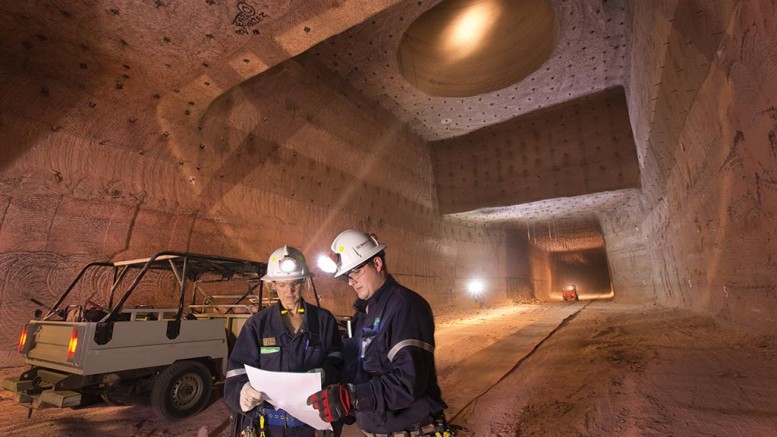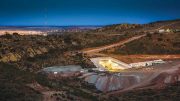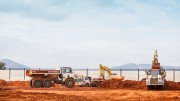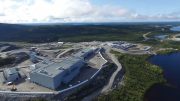The Northern Miner presents the top 10 Canadian-headquartered mining companies by market capitalization, as of early July 2018.
- NUTRIEN: $46 billion market cap
Nutrien (TSX: NTR; NYSE: NTR) is a new addition to corporate Canada, the result of 2018 merger between Potash Corp. of Saskatchewan — the world’s largest potash producer, second largest phosphate producer, and third largest nitrogen producer — and Agrium, a retail supplier of agricultural products and services. PotashCorp was created by the Saskatchewan government in 1975, was privatized in 1989, and acquired a number of American potash producers in the 1990s. With a market capitalization of $46 billion and 2017 revenue of $17.3 billion, it is one of the largest companies in Canada.
- BARRICK GOLD: $20 billion market cap

Barrick Gold’s Goldstrike gold mine in Nevada in 2006. Credit: Barrick Gold.
Barrick Gold (TSX: ABX; NYSE: ABX) is no longer the world’s largest gold mining company, having been recently surpassed by Newmont. The company has assets across the Americas, Africa, the Middle East, Australia and Indonesia. Following years of losses, ballooning debt and credit downgrades, the company has strengthened its balance sheet and returned to profitability by selling off its non-core assets, paying down debt and focusing on core operations. Barrick expects to mine 4.5 million to 5.0 million oz. gold in 2018.
- TECK RESOURCES: $19 billion market cap

A haul truck at the Fort Hills oilsands project, 90 km north of Fort McMurray, Alberta. The project, which produced first oil in January, is owned by Suncor Energy (53.06%), Total E&P Canada (26.05%) and Teck Resources (20.89%). Credit: Suncor Energy.
Teck Resources (TSX: TECK; NYSE: TECK) had a banner year in 2017, posting a record $12 billion in revenue and $3 billion in cash flow thanks to cost reductions and a rebound in commodity prices. Teck Resources emerged from the merger of Teck and Cominco in 2001. The company is Canada’s largest diversified resources producer, with a focus on coal, copper, zinc and energy production. Teck owns, outright or partially, 12 mines, a metallurgical complex, an oilsands mining and processing operation, and several major development projects in Canada, the U.S., Chile and Peru. Teck’s first foray into the oil business culminated early this year with first oil at the Fort Hills oilsands mine in Alberta, a joint venture it has a 20% stake in. Its controversial Frontier oilsands mine in Alberta faces a joint federal-provincial regulatory review this fall.
- GOLDCORP: $15 billion market cap

Tele-remote operators working at Goldcorp’s Red Lake gold mine in Ontario. Credit: Goldcorp.
Goldcorp’s (TSX: G; NYSE: GG) ambitious growth plan targets a 20% increase in both gold reserves and annual production and a 20% reduction in all-in sustaining costs by 2021. To meet its targets for increased production, the company is relying on a ramp-up in production at its Cerro Negro and Éléonore mines, and an increase in both grade and output at its Peñasquito mine following the execution of a stripping campaign and leach project. In 2018, Goldcorp plans on using funds from the sale of non-core assets to its operations in Chile and the Yukon. As of 2017, the company has 53.5 million oz. of gold reserves.
- AGNICO EAGLE MINES: $14 billion market cap

Workers at a section of the Rail-Veyor system at Agnico Eagle Mines’ Goldex underground gold mine near Val-d’Or, Quebec. Photo by John Cumming.
Agnico Eagle Mines (TSX: AEM, NYSE: AEM) is expanding production with the $1.2 billion construction of its two Nunavut gold mines: Meliadine and Amaruq. The 60-year old Toronto-based company, whose flagship LaRonde gold mine has funded much of its expansion over the past two decades, has eight producing gold mines in Quebec, Nunavut, Finland and Mexico and exploration and development activities in Sweden and the United States. CEO Sean Boyd, The Northern Miner’s 2007 and 2017 Mining Person of the Year, has led the company since 1998. Agnico Eagle has a no forward sales policy, resulting in a full exposure to the spot gold price. As of 2017, the company has 20.6 million oz. of gold reserves.
- FIRST QUANTUM MINERALS: $13 billion market cap

First Quantum Minerals’ 80%-owned Kansanshi copper mine in Zambia. Credit: First Quantum Minerals.
First Quantum Minerals (TSX: FM; US-OTC: FQVLF) nearly went bankrupt in 2016 following a poorly executed takeover of Inmet Mining in 2013 and a significant decrease in copper prices. It sold off assets, including a nickel mine in northern Finland, to strengthen its balance sheet and regain investor confidence. The principal asset in the Inmet acquisition, the Cobre Panama copper mine, is slated to begin commercial production in 2019. First Quantum is currently fighting an $8 billion tax bill with the Zambian government. The company has 4.2 million tonnes of copper reserves and a market capitalization of $12.8 billion.
- TURQUOISE HILL RESOURCES: $8 billion market cap

The large Oyu Tolgoi copper-gold operation in Mongolia. Credit: Rio Tinto.
Turquoise Hill Resources’ (TSX: TRQ; NYSE: TRQ) sole asset is the combined open pit and underground Oyu Tolgoi copper-gold mine in Mongolia, which is currently being operated by Rio Tinto, Turquoise Hill’s majority shareholder. Oyu Tolgoi is 66% owned by Turqoise Hill and 34% owned by the Mongolian government. Oyu Tolgoi’s development has been rife with controversy and tension between the two partners over issue such as tax payments, corruption and power supply. Once ramped up to the next stage of development, the mine is expected to produce 450,000 tonnes copper annually.
- KINROSS GOLD: $6 billion market cap

Kinross Gold’s 50%-owned Round Mountain gold mine in Nye County, Nevada. Credit: Kinross Gold.
Kinross Gold (TSX: K; NYSE: KCG) has spent the better part of the last decade trying to emerge from its disastrous acquisition of Red Back Mining, which was written down by an astonishing 80% within two years. The company currently has nine active gold mines in the Americas, Russia and West Africa. Last December, Kinross added 2.1 million ounces of gold reserves through its purchase of the mineral rights to Gilmore, a 709-acre parcel adjacent to its existing Fort Knox gold mine outside of Fairbanks, Alaska. As of 2017, the company has 26 million oz. of gold reserves and 53 million oz. of silver reserves.
- CAMECO: $5.6 billion market cap

A worker readies U3O8 drums to ship from Cameco’s Key Lake uranium mill in Saskatchewan. Credit: Cameco.
Cameco (TSX: CCO; NYSE: CCJ) is the world’s largest publicly traded uranium miner. The company was formed through the merger of two Crown corporations in 1988. Full privatization occurred in 2002, 11 years after its initial public offering. Cameco operates four active uranium mines — two in the U.S., one in Canada and one in Kazakhstan. The company has struggled amidst a slump in uranium prices that began after the Fukushima nuclear disaster and was compounded by Germany’s ensuing commitment to phase out all of its nuclear power plants. Two of its mines, representing 40% of production, remain closed as a result. Cameco has 458 million lb. of uranium oxide reserves.
- KIRKLAND LAKE GOLD: $5 billion market cap

Underground at Kirkland Lake Gold’s Macassa gold mine in Ontario. Credit: Kirkland Lake Gold.
Kirkland Lake Gold Ltd. (TSX: KL; NYSE: KL), the product of a 2016 merger between Kirkland Lake Gold Inc. and Australia-based Newmarket Gold, has taken the industry by storm in the past three years. Its two largest assets — the Macassa mine in northern Ontario and the Fosterville mine in Australia — have consistently beat expectations for output, reserves and grade. In the first half of 2018, Macassa produced 114,609 oz. gold with a grade of 20.5 grams gold per tonne and Fosterville produced 141,305 oz. gold with a grade of 18.7 grams gold.






Thank you for this helpful overview.